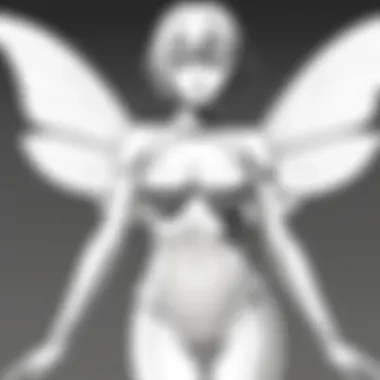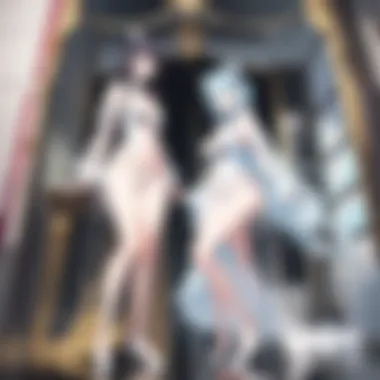Exploring Metamorphosis in Manga: Themes and Impact


Intro
Metamorphosis is a central theme in many forms of storytelling, but in manga, it holds a particularly unique significance. This article explores how transformation manifests in manga narratives, impacting both characters and readers. Understanding this theme requires examining various genres, notable works, and the narrative techniques that make metamorphosis a compelling subject of exploration.
In the context of manga, metamorphosis often serves as a metaphor for character growth or societal change. It captures moments of existential doubt, personal evolution, and, at times, tragic downfall. By diving deeper into the diverse representations of metamorphosis, we can appreciate its thematic depth, allowing us to connect more profoundly with the stories and characters we encounter.
The examination extends beyond mere transformations; it envelops the psychological implications that accompany these changes. Characters may undergo physical, emotional, or social metamorphoses—each conveying a narrative rich in meaning. This article aims to illuminate how these changes resonate with readers, providing insight into human experiences and the complexity of identity.
Understanding Metamorphosis in the Context of Manga
Metamorphosis serves as a vital theme in manga, deeply resonating with both creators and audiences. This concept encapsulates change and transformation, reflective of the human experience. It can represent growth, struggle, and the challenges faced when adapting to new circumstances. By analyzing metamorphosis in manga, readers gain insight into not only character evolution but also societal reflections mirrored through these narratives.
Defining Metamorphosis
Metamorphosis, fundamentally, is the process of transformation. In the lexical sense, it originates from the Greek ‘metamorphoun,’ meaning to change form. In manga, this concept extends beyond mere physical changes. It includes profound emotional and psychological shifts that characters undergo throughout their stories. This multifaceted aspect allows for a richer understanding of characters and their journeys.
The representation of metamorphosis is often literal, such as in body transformations or shifts in appearance. However, it can also be metaphorical, highlighting internal changes influenced by external factors or personal experiences. These layered interpretations contribute to the depth of character narratives and enrich the overall storytelling.
Historical Context
To appreciate the theme of metamorphosis in manga, one must consider its historical evolution. The roots of metamorphosis in storytelling can be traced back to ancient mythology and literature. Works like Ovid's 'Metamorphoses' showcase characters undergoing significant changes, which resonate strongly in the narrative arcs of manga.
In Japan, the metamorphosis theme began to take shape with traditional art forms and folktales, where characters often faced transformations tied to moral lessons or supernatural elements. As manga emerged in the mid-20th century, these influences fused with contemporary storytelling techniques. Authors like Osamu Tezuka laid the groundwork for exploring psychological and societal transformations, setting a precedent for future works in the medium.
Thematic Elements of Transformation
Understanding the thematic elements of transformation is essential for analyzing how metamorphosis functions within manga narratives. This theme goes beyond mere physical changes. It encompasses various dimensions, including psychological shifts and social contexts. Each aspect of transformation serves to enrich character development and storyline depth. It provides insight into the complex human experiences illustrated in manga. Additionally, these elements can foster a stronger connection between the reader and the characters. By exploring these themes, one can appreciate how they contribute to both the narrative structure and emotional resonance of the story.
Physical Transformations
Physical transformations are often the most visible aspect of metamorphosis in manga. Characters may undergo significant changes in their appearance, which can symbolize deeper internal struggles or growth. This element can manifest in various ways, such as monstrous evolutions in horror manga or elegant changes in fantasy genres. The power of visual representation cannot be underestimated. Physical changes grab attention and convey shifts in a character's identity or fate. Such transformations can serve as a powerful narrative device, pushing the plot forward and offering new challenges for the characters to face.
For instance, in works like "Tokyo Ghoul," Kaneki’s physical metamorphosis into a ghoul impacts his relationships and worldview. This stark change highlights the clash between human and monstrous identities. The transformation is palpable, evoking strong reactions from readers. Ultimately, physical transformations in manga are a compelling way to explore themes of identity and evolution.
Psychological Changes
The psychological aspect of metamorphosis is often intertwined with physical transformations, but it carries its own significance. Characters may face identity crises, grappling with who they are versus who they are becoming. This theme allows readers to engage with characters on a more profound level. As characters endure struggles within themselves, they often reflect larger societal issues. Psychological changes can illustrate the effects of trauma, loss, or the quest for belonging.
In series such as "Neon Genesis Evangelion," characters like Shinji Ikari experience psychological shifts as they confront their fears and insecurities. These transformations offer insights into the complexities of mental health.
Understanding psychological changes in characters leads to greater empathy and depth of experience for readers. The inner workings of a character's mind can profoundly shape their actions and relationships.
Social Metamorphosis
Social metamorphosis is a critical aspect of transformation in manga, reflecting how characters evolve within their societal context. This form of transformation often highlights issues of status, belonging, and acceptance. Characters may rise or fall within their social structures, and these changes can serve as commentary on societal norms and values. By portraying characters who adapt to or reject societal expectations, manga can challenge established ideas and push boundaries.
For instance, in "Attack on Titan," the social dynamics within and outside the walls serve as a backdrop for exploring themes of freedom and oppression. Characters like Eren Yeager experience profound transformations not just in their personal identity but also in their social standing. Their choices affect their relationships with others in the story.
Social metamorphosis, therefore, offers a lens to understand the interplay between individual journeys and collective experiences. It encourages readers to reflect on their own social environments and the pressures they face.


By examining these thematic elements of transformation in manga, one can appreciate the intricate layers of meaning that contribute to a richer storytelling experience. The interplay of physical, psychological, and social changes showcases the complexity of human experience and the universality of metamorphosis.
Noteworthy Manga Featuring Metamorphosis
The theme of metamorphosis in manga has offered a substantial narrative tool, allowing authors to explore profound implications of change and transformation in their characters and storylines. This topic is significant because it gives readers insight into the psychological, social, and personal shifts characters undergo through their journeys. The impactful nature of metamorphosis can resonate with audiences, leading them to reflect on their own experiences of change. When discussing noteworthy manga that embody this concept, it is essential to consider how these works contribute to the broader discourse on identity, society, and the human condition.
Classic Examples
Classic examples of metamorphosis in manga often serve as foundational texts that have shaped how this theme is represented. One of the most recognized works is Akira, written by Katsuhiro Otomo. The narrative dives into societal collapse, youth rebellion, and technological transformation, with Akira’s transformation representing more than physical change; it embodies societal fears and desires. Another classic title is Naruto by Masashi Kishimoto, where the protagonist's evolution from an outcast to a hero symbolizes personal growth and mastery over one's fears and insecurities. These early examples set strong precedents in manga for elaborating on the nuances of transformation, not just in actions but also in character motivations and internal struggles.
Contemporary Works
Contemporary manga has taken the theme of metamorphosis in new and innovative directions. Works like Tokyo Ghoul by Sui Ishida showcase characters grappling with dual identities and the struggle for acceptance. Kaneki's transformation into a ghoul functions as a narrative device that explores issues of belonging and individuality. Similarly, My Dress-Up Darling by Shinichi Fukuda reflects on the metamorphosis of characters through fandom and self-expression, illustrating how outward change can often lead to deeper self-understanding. These contemporary works highlight a departure from solely physical transformations to more layered psychological evolutions that captivate modern audiences.
Independent and Web Comics
The realm of independent and web comics has also contributed significantly to the narrative of metamorphosis in manga. Platforms like Webtoon and Tapas have unleashed a diverse array of stories reflecting personal and cultural changes. Lore Olympus, a modern retelling of the myth of Hades and Persephone by Rachel Smythe, exemplifies how metamorphosis interweaves with themes of love and power, illustrating social dynamics in a contemporary context. In addition, Sarimeki by Rin Azumaki explores experimental forms of transformation as characters navigate their desires and fears in unique social structures, making it a noteworthy mention in this genre. Independent works often display radical approaches to storytelling; they experiment with structure, form, and depth, enriching the existing landscape of metamorphosis in manga.
Mechanisms of Transformation
The topic of mechanisms of transformation is crucial in understanding how metamorphosis operates within manga. This section will delve into two main aspects: the symbolism found in artwork and the narrative devices that convey transformation. Each of these elements plays a significant role in illustrating the complexities of change, both visually and thematically. By identifying these mechanisms, one can appreciate how they contribute to the overall impact of metamorphosis on characters and plot.
Symbolism in Artwork
In manga, symbolism operates as a powerful tool to convey transformation. Artists often use visual elements to represent changes in a character's state. For instance, a character's physical form can shift in response to their emotional or mental state. The art style may shift from detailed illustrations to more abstract representations to indicate this change.
Common symbols include:
- Nature: Elements like butterflies often represent free-spiritedness and change. In many stories, transformation aligns with the natural world, presenting an idea of growth or evolution.
- Shadows: Darkening or brightening shadows in panels can mirror the psychological weight a character bears during their metamorphosis.
- Color: The use of color can dictate the mood and highlight the significance of transformation. For example, vibrant colors can suggest rejuvenation, whereas muted tones may signify struggle and conflict.
The effective use of these symbolic representations enhances the reader's ability to connect with the character's journey. The transformations become more resonant and impactful when layered with visual cues that instill deeper meaning.
Narrative Devices
Alongside artistic symbolism, narrative devices play an essential role in orchestrating transformation in manga. Various storytelling techniques facilitate the representation of character metamorphosis, enabling readers to engage with the transformations on multiple levels.
Key narrative devices include:
- Flashbacks: These moments allow readers to see a character's past and understand the journey leading up to their current state. Flashbacks can pinpoint critical events that trigger transformation.
- Inner Monologues: The thoughts of a character often expose their internal struggles and fears, providing context for the changes occurring. This device helps readers to empathize with the character and recognize the nuances of their transformation.
- Foreshadowing: Subtle hints about a future transformation can be embedded in earlier parts of the story. This technique engages readers by building anticipation and curiosity regarding the nature of the change.
These narrative devices not only enhance the storytelling but also ensure that the theme of metamorphosis resonates throughout the manga. By intertwining visual symbolism with deliberate narrative choices, creators are able to craft rich, layered stories that delve into the essence of change and transformation in their characters.
"Metamorphosis in manga is not just about physical change, but it also encapsulates emotional and psychological development that connects with the reader at a fundamental level."
Through careful examination of these mechanisms, one can discern the intricate ways in which metamorphosis is articulated in manga. This depth adds considerable value to character arcs and contributes to the overarching themes of identity, growth, and self-discovery.
Character Development through Metamorphosis
The theme of metamorphosis plays a significant role in character development within manga. It is a lens through which we observe how protagonists evolve or regress throughout their journeys. By examining this theme, we can uncover layers of complexity in character motivations and growth. A well-executed transformation can reflect the internal struggles of characters, showing how their experiences shape their identities.


The importance of metamorphosis lies in the way it highlights pivotal moments in a character's life. When characters undergo change, they often confront challenges that test their values and beliefs. These transformations may be physical, psychological, or emotional and serve to deepen the narrative and engage the reader.
Archetypes of Transformation
In manga, certain archetypes are frequently depicted, showcasing various types of transformation. One common archetype is the hero's journey. Characters who start in a place of weakness often experience a metamorphosis that leads to their full potential. For example, Shinji Ikari from Neon Genesis Evangelion represents the archetype of struggle. His displacement and growth emphasize personal identity.
Another notable archetype is the antihero. Characters such as Guts from Berserk illustrate dark metamorphosis, highlighting the impact of trauma on the soul. This transformation is often gradual and tumultuous, reflecting the complexities of human emotion.
Key Archetypes in Manga:
- The Reluctant Hero: Often hesitant to accept their role, but ultimately transforms into a leader.
- The Innocent: Begins with naivety, but faces harsh realities that catalyze their change.
- The Seeker: These characters actively search for truth or identity, often experiencing dramatic growth.
Impact on Relationships
Metamorphosis significantly impacts the relationships between characters. As individuals change, their interactions with others also shift. For instance, a character who transforms physically may lead friends to treat them differently. This change can catalyze both conflict and resolution within relationships. The tension created by transformations not only adds depth to the narrative but also explores themes of acceptance and understanding.
Consider the following effects of metamorphosis on relationships:
- Divergence: Characters who change may find themselves drifting apart from former allies.
- Strengthening Bonds: Alternatively, transformations can lead to deeper connections through shared experiences.
- Conflict: Conflicting identities can spur tension, promoting character growth.
Ultimately, the exploration of metamorphosis in character development fosters a richer storytelling experience. It encourages readers to consider the multifaceted nature of growth and the impact of change on relationships and personal identity.
Psychological Implications of Transformation
The exploration of psychological implications stemming from metamorphosis in manga unveils deep insights into character motivations and reader connections. These implications reveal how transformations influence identity and emotional depth in narratives. Through examining these themes, audiences gain a better understanding of both the characters' struggles and their own human experiences, such as empathy, anxiety, and self-image issues.
Identity Crisis
Identity crisis is a prevalent psychological theme in many manga that depict metamorphosis. Characters often face profound changes in their appearance or abilities, prompting a reevaluation of their self-concept. This issue resonates with readers, particularly among adolescents, who are navigating their own identity formation. For instance, in works such as Naruto, characters undergo physical transformations that reflect their inner struggles. Naruto Uzumaki, for example, evolves from a misunderstood outcast into a pivotal figure, challenging preconceived notions of self-worth and belonging.
The psychological conflict arising from these transformations often leads to an identity crisis, raising critical questions about authenticity and the self. Some readers connect deeply with these transformations, viewing them as metaphors for their own real-life challenges. This connection underscores the importance of the theme, as it fosters introspection and growth among readers, engaging a broad audience.
Empathy and Understanding
Metamorphosis often provides a lens through which readers can cultivate empathy and understanding. As characters change physically, emotionally, or socially, they often face isolation or rejection. This aspect elicits compassion from the audience, as their struggles are relatable on a human level. In Tokyo Ghoul, for example, Kaneki Ken’s transformation into a ghoul yields a poignant commentary on societal alienation. Readers witness his internal battle between humanity and monstrosity, which raises questions about what it means to be human.
Through these narratives, manga encourages readers to develop empathy for those who are different. As characters grapple with their altered realities, readers learn to appreciate the complexity of human existence. Transformations serve to highlight the shared vulnerability inherent in all individuals, fostering societal awareness.
"Transformation is not merely a physical change; it invites introspection and a profound understanding of the self."
Overall, the psychological implications of metamorphosis in manga extend far beyond the visual representation of change. They touch upon core aspects of human identity, connecting readers to wide-ranging themes of crisis and empathy. Through the lens of metamorphosis, manga holds potential for deeper exploration of individual struggles and the shared experiences that bind us all.
Cultural Reflections through Metamorphosis
The theme of metamorphosis in manga is not merely a narrative device but also a mirror reflecting cultural values and societal changes. This section explores how metamorphosis serves as a lens to investigate the evolving identity and expectations of individuals in society. By examining the cultural context of transformation through manga, we can appreciate the broader implications of these narratives on both Japanese culture and global audiences.
Metamorphosis in Japanese Culture
In Japanese culture, transformation holds a distinct and rich significance. It often ties back to mythology and folklore. For instance, tales of beings transforming into deities or yokai reveal deep-rooted views on the fluidity of identity. This cultural backdrop provides a fertile ground for manga artists to explore themes of metamorphosis.


Manga such as "Naruto" or "My Hero Academia" approaches identity changes through their characters’ journeys. Here, heroes and villains undergo physical and psychological transformations that reflect societal pressures, aspirations, and the struggle for acceptance. These stories resonate with a Japanese audience familiar with the concept of change as both a challenge and an opportunity.
Considerations of gender roles, societal expectations, and personal desires often intersect within manga narratives. Characters may become stronger or adopt new identities that reflect personal growth, embodying aspirations that resonate with readers. This can lead to a greater understanding of societal positions and personal development.
Global Reception and Interpretation
As manga has gained global popularity, the theme of metamorphosis has been receptive to varied interpretations across cultures. International audiences engage with these stories, bringing their perceptions and experiences to the narratives.
In North America and Europe, for instance, the concept of transformation may evoke different meanings. Western interpretations often focus on individualism and personal agency. Readers find liberation in stories of transformation as they connect with themes of self-discovery and empowerment. Manga like "Tokyo Ghoul" or "Attack on Titan" reflect this, where characters face existential threats that compel them to redefine who they are.
Metamorphosis in manga exemplifies how cultural narratives shift according to audience perception, offering a wealth of interpretations and connections to contemporary issues.
There is also an ongoing dialogue about how migration and global exchange influence the creation and reception of metamorphosis themes in manga. Stories that highlight hybrid identities resonate with readers who navigate multiple cultural contexts. These reflections can be powerful discussions on identity, belonging, and the search for one’s place in a diverse world.
Through this cross-cultural exchange, metamorphosis not only captivates readers but also ignites conversations about change, acceptance, and the multifaceted nature of identity, reinforcing its relevance in both Japanese culture and the global arena.
The Future of Metamorphosis in Manga
The ongoing evolution of manga suggests that the theme of metamorphosis will continue to play a crucial role in narrative structures and character development. The exploration of transformation is not merely about physical changes; it encompasses psychological shifts and sociocultural implications. As manga continues to gain popularity worldwide, understanding the future of metamorphosis in this art form can yield insights into emerging trends and the potential new directions authors might take.
Emerging Trends
New technologies and cultural shifts are shaping how metamorphosis is represented in manga. The rise of digital platforms has led many creators to experiment with interactive storytelling. Readers can now engage with stories in ways that were not possible before. For instance, new platforms allow for animated scrolls or choices that affect the storyline. This means that physical and psychological transformations in characters may also be presented in more dynamic ways.
- Realism vs. Fantasy: There is a growing trend towards blending elements of realism with fantastical chronicles. Manga that showcases characters undergoing transformations that feel relatable and grounded can lead to deeper reader connections.
- Gender and Identity: The discussions surrounding gender and identity are becoming more prevalent in society. Manga is adapting to reflect this shift, with many works portraying characters that experience transformations related to their identities. This can foster dialogues on acceptance, and the fluidity of identities, pushing the narrative boundaries further.
- Global Influence: Manga now influences, and is influenced by, global storytelling trends. Cross-cultural exchanges are visible in many new works, which incorporate various narrative styles and themes from different cultures that also reflect metamorphic elements.
Potential New Directions
As manga continues to evolve, potential new directions present interesting possibilities for future works focused on metamorphosis. These could involve innovations in storytelling methods and deeper dives into complex themes.
- Exploration of Technology: With advancements in VR and AR, the potential for immersive storytelling in manga is immense. Characters could experience literal transformations in ways that readers can experience more deeply as technologies converge.
- Social Commentary: Future works may increasingly utilize metamorphosis as a metaphor for social issues. Creators might explore subjects such as climate change, technology's impact on humanity, or mental health struggles, using transformative elements to illustrate the reality of these issues.
- Personal Narratives: There’s a likelihood of more autobiographical or personal narratives that might focus on the author’s own experiences of metamorphosis. This could provide readers with an intimate glimpse into the transformative processes of individual lives, thus fostering stronger emotional connections.
The future of metamorphosis in manga holds the potential for profound exploration of self and society, echoing the continual search for identity and connection in an ever-changing world.
As we look ahead, it remains clear that metamorphosis will not only continue to resonate within manga but will also serve as a lens through which readers can explore their own transformations in the face of societal changes.
Epilogue
Metamorphosis in manga serves as a profound exploration of identity and transformation. This conclusion synthesizes the key themes discussed throughout the article while underscoring the lasting impact metamorphosis has on both characters and readers. The thematic depth found in these narratives fosters a connection with audiences, allowing them to reflect on their personal experiences.
Summarizing Key Insights
- Theme of Change: Characters often undergo significant transformations that mirror real-life challenges.
- Character Development: These transformations are essential for character arcs and deepen the reader's engagement with the story.
- Psychological Effects: Metamorphosis raises questions about self-identity, leading to relatable moments for readers.
This topic reveals several layers of complexity that are crucial for understanding the narratives in manga literature.
Reflection on the Significance of Metamorphosis
The concept of metamorphosis transcends mere physical change. It embodies a multifaceted approach to storytelling.
- Cultural Metaphors: In many narratives, transformation represents broader cultural and personal struggles.
- Empathy Building: Readers connect deeply with characters as they witness their struggles and growth.
- Literary Innovation: Manga creators utilize the idea of transformation to push boundaries and engage audiences in unique ways.
"The beauty of metamorphosis is not just in the change itself but in the journey it encompasses."
The significance of metamorphosis in manga ultimately highlights complex human experiences, making it a central theme worthy of exploration in this art form.







